Impact of Scene Content on High Resolution Video Quality
Abstract
1. Introduction
2. Dataset Description and Preparation
2.1. Dataset Description
2.2. Dataset Preparation
2.3. Coding Process
3. Subjective Quality Assessment
4. Statistical Analysis and Presentation of the Results
4.1. Correlation between the Results from Individual Laboratories
4.2. Impact of Bitrate on Video Quality Depending on Scene Content
- at low bitrates—with increasing bitrate, the perceived quality rises, too, and approaches the perceived quality of sequences with low SI-TI values,
- at Ultra HD resolution rather than at Full HD resolution, and
- at H.265 codec rather than at H.264 codec.
4.3. Analysis of Variance
4.4. Impact of Bitrate on Video Quality Depending on Codec and Resolution
4.5. Minimum Bitrate Thresholds Suggestions
5. Conclusions
Author Contributions
Funding
Institutional Review Board Statement
Informed Consent Statement
Data Availability Statement
Conflicts of Interest
References
- Damer, N.; Grebe, J.H.; Chen, C.; Boutros, F.; Kirchbuchner, F.; Kuijper, A. The Effect of Wearing a Mask on Face Recognition Performance: An Exploratory Study. In Proceedings of the 2020 International Conference of the Biometrics Special Interest Group (BIOSIG), Darmstadt, Germany, 16–18 September 2020; pp. 1–6. [Google Scholar]
- Joshi, A.S.; Joshi, S.S.; Kanahasabai, G.; Kapil, R.; Gupta, S. Deep Learning Framework to Detect Face Masks from Video Footage. In Proceedings of the 2020 12th International Conference on Computational Intelligence and Communication Networks (CICN), Bhimtal, India, 25–26 September 2020. [Google Scholar]
- Tan, W.; Liu, J. Application of Face Recognition in Tracing COVID-19 Fever Patients and Close Contacts. In Proceedings of the 2020 19th IEEE International Conference on Machine Learning and Applications (ICMLA), Miami, FL, USA, 14–17 December 2020. [Google Scholar]
- Seshadrinathan, K.; Soundararajan, R.; Bovik, A.C.; Cormack, L.K. Study of Subjective and Objective Quality Assessment of Video. IEEE Trans. Image Process. 2010, 19, 1427–1441. [Google Scholar] [CrossRef] [PubMed]
- Seshadrinathan, K.; Soundararajan, R.; Bovik, A.C.; Cormack, L.K. A subjective study to evaluate video quality assessment algorithms. In Human Vision and Electronic Imaging XV; Rogowitz, B.E., Pappas, T.N., Eds.; SPIE: Bellingham, WA, USA, 2010. [Google Scholar]
- Moorthy, A.K.; Choi, L.K.; Bovik, A.C.; de Veciana, G. Video Quality Assessment on Mobile Devices: Subjective, Behavioral and Objective Studies. IEEE J. Sel. Top. Signal Process. 2012, 6, 652–671. [Google Scholar] [CrossRef]
- Moorthy, A.K.; Choi, L.K.; Veciana, G.; Bovik, A. Subjective Analysis of Video Quality on Mobile Devices. In Proceedings of the 6th International Workshop on Video Processing and Quality Metrics for Consumer Electronics (VPQM), Scottsdale, AZ, USA, 19–20 January 2012; Volume 720, pp. 1–6. [Google Scholar]
- Chen, C.; Choi, L.K.; de Veciana, G.; Caramanis, C.; Heath, R.W.; Bovik, A.C. A dynamic system model of time-varying subjective quality of video streams over HTTP. In Proceedings of the 2013 IEEE International Conference on Acoustics, Speech and Signal Processing, Vancouver, BC, Canada, 26–31 May 2013. [Google Scholar]
- Chen, C.; Zhu, X.; de Veciana, G.; Bovik, A.C.; Heath, R.W. Adaptive video transmission with subjective quality constraints. In Proceedings of the 2014 IEEE International Conference on Image Processing (ICIP), Paris, France, 27–30 October 2014. [Google Scholar]
- Chen, C.; Choi, L.K.; de Veciana, G.; Caramanis, C.; Heath, R.W.; Bovik, A.C. Modeling the Time—Varying Subjective Quality of HTTP Video Streams With Rate Adaptations. IEEE Trans. Image Process. 2014, 23, 2206–2221. [Google Scholar] [CrossRef] [PubMed]
- Chen, C.; Zhu, X.; de Veciana, G.; Bovik, A.C.; Heath, R.W. Rate Adaptation and Admission Control for Video Transmission With Subjective Quality Constraints. IEEE J. Sel. Top. Signal Process. 2015, 9, 22–36. [Google Scholar] [CrossRef]
- Choi, L.K.; Cormack, L.K.; Bovik, A.C. On the visibility of flicker distortions in naturalistic videos. In Proceedings of the 2013 Fifth International Workshop on Quality of Multimedia Experience (QoMEX), Klagenfurt am Wörthersee, Austria, 3–5 July 2013. [Google Scholar]
- Choi, L.K.; Cormack, L.K.; Bovik, A.C. Motion silencing of flicker distortions on naturalistic videos. Signal Process. Image Commun. 2015, 39, 328–341. [Google Scholar] [CrossRef]
- Choi, L.K.; Cormack, L.K.; Bovik, A.C. Eccentricity effect of motion silencing on naturalistic videos. In Proceedings of the 2015 IEEE Global Conference on Signal and Information Processing (GlobalSIP), Orlando, FL, USA, 14–16 December 2015. [Google Scholar]
- Choi, L.K.; Cormack, L.K.; Bovik, A.C. LIVE Flicker Video Database. 2015. Available online: http://live.ece.utexas.edu/research/quality/live_flicker_video.html (accessed on 18 April 2021).
- Ghadiyaram, D.; Bovik, A.C.; Yeganeh, H.; Kordasiewicz, R.; Gallant, M. Study of the effects of stalling events on the quality of experience of mobile streaming videos. In Proceedings of the 2014 IEEE Global Conference on Signal and Information Processing (GlobalSIP), Atlanta, GA, USA, 3–5 December 2014. [Google Scholar]
- Ghadiyaram, D.; Bovik, A.; Yeganeh, H.; Kordasiewicz, R.; Gallant, M. LIVE Mobile Stall Video Database, 2016. Available online: http://live.ece.utexas.edu/research/LIVEStallStudy/index.html (accessed on 18 April 2021).
- Ghadiyaram, D.; Pan, J.; Bovik, A.C.; Moorthy, A.K.; Panda, P.; Yang, K.C. In-Capture Mobile Video Distortions: A Study of Subjective Behavior and Objective Algorithms. IEEE Trans. Circuits Syst. Video Technol. 2018, 28, 2061–2077. [Google Scholar] [CrossRef]
- Ghadiyaram, D.; Pan, J.; Bovik, A.C.; Moorthy, A.K.; Panda, P.; Yang, K.C. LIVE-Qualcomm Mobile In-Capture Video Quality Database, 2017. Available online: http://live.ece.utexas.edu/research/incaptureDatabase/index.html (accessed on 18 April 2021).
- Bampis, C.G.; Li, Z.; Moorthy, A.K.; Katsavounidis, I.; Aaron, A.; Bovik, A.C. Study of Temporal Effects on Subjective Video Quality of Experience. IEEE Trans. Image Process. 2017, 26, 5217–5231. [Google Scholar] [CrossRef] [PubMed]
- Bampis, C.G.; Li, Z.; Moorthy, A.K.; Katsavounidis, I.; Aaron, A.; Bovik, A.C. LIVE Netflix Video Quality of Experience Database, 2016. Available online: http://live.ece.utexas.edu/research/LIVE_NFLXStudy/nflx_index.html (accessed on 18 April 2021).
- Ghadiyaram, D.; Pan, J.; Bovik, A.C. A Subjective and Objective Study of Stalling Events in Mobile Streaming Videos. IEEE Trans. Circuits Syst. Video Technol. 2019, 29, 183–197. [Google Scholar] [CrossRef]
- Ghadiyaram, D.; Pan, J.; Bovik, A. LIVE Mobile Stall Video Database-II, 2017. Available online: http://live.ece.utexas.edu/research/LIVEStallStudy/index.html (accessed on 18 April 2021).
- Bampis, C.G.; Li, Z.; Katsavounidis, I.; Huang, T.Y.; Ekanadham, C.; Bovik, A. Towards Perceptually Optimized End-to-end Adaptive Video Streaming. arXiv 2018, arXiv:1808.03898. [Google Scholar]
- Sinno, Z.; Bovik, A.C. Large Scale Subjective Video Quality Study. In Proceedings of the 2018 25th IEEE International Conference on Image Processing (ICIP), Athens, Greece, 7–10 October 2018. [Google Scholar]
- Sinno, Z.; Bovik, A.C. Large-Scale Study of Perceptual Video Quality. IEEE Trans. Image Process. 2019, 28, 612–627. [Google Scholar] [CrossRef] [PubMed]
- Sinno, Z.; Bovik, A. LIVE Video Quality Challenge Database, 2018. Available online: http://live.ece.utexas.edu/research/LIVEVQC/index.html (accessed on 18 April 2021).
- VQEG Database. 2010. Available online: https://www.its.bldrdoc.gov/vqeg/projects/frtv-phase-i/frtv-phase-i.aspx (accessed on 18 April 2021).
- Zhang, F.; Moss, F.M.; Baddeley, R.; Bull, D.R. BVI-HD: A Video Quality Database for HEVC Compressed and Texture Synthesized Content. IEEE Trans. Multimed. 2018, 20, 2620–2630. [Google Scholar] [CrossRef]
- Papadopoulos, M.A.; Zhang, F.; Agrafiotis, D.; Bull, D. A video texture database for perceptual compression and quality assessment. In Proceedings of the 2015 IEEE International Conference on Image Processing (ICIP), Quebec City, QC, Canada, 27–30 September 2015. [Google Scholar]
- Mackin, A.; Zhang, F.; Bull, D.R. A study of subjective video quality at various frame rates. In Proceedings of the 2015 IEEE International Conference on Image Processing (ICIP), Quebec City, QC, Canada, 27–30 September 2015. [Google Scholar]
- Rao, R.R.R.; Goring, S.; Robitza, W.; Feiten, B.; Raake, A. AVT-VQDB-UHD-1: A Large Scale Video Quality Database for UHD-1. In Proceedings of the 2019 IEEE International Symposium on Multimedia (ISM), San Diego, CA, USA, 9–11 December 2019. [Google Scholar]
- Mercat, A.; Viitanen, M.; Vanne, J. UVG dataset. In Proceedings of the 11th ACM Multimedia Systems Conference, Istanbul, Turkey, 28 September–1 October 2020. [Google Scholar]
- Song, L.; Tang, X.; Zhang, W.; Yang, X.; Xia, P. The SJTU 4K video sequence dataset. In Proceedings of the 2013 Fifth International Workshop on Quality of Multimedia Experience (QoMEX), Klagenfurt am Wörthersee, Austria, 3–5 July 2013. [Google Scholar]
- IVP Database. 2011. Available online: http://ivp.ee.cuhk.edu.hk/index.shtml (accessed on 18 April 2021).
- Péchard, S.; Pépion, R.; Le Callet, P. Suitable Methodology in Subjective Video Quality Assessment: A Resolution Dependent Paradigm. In Proceedings of the International Workshop on Image Media Quality and Its Applications, IMQA2008, Kyoto, Japan, 5–6 September 2008; Volume 6. [Google Scholar]
- The Konstanz Natural Video Database. Available online: http://database.mmsp-kn.de/konvid-1k-database.html (accessed on 18 April 2021).
- Hosu, V.; Hahn, F.; Jenadeleh, M.; Lin, H.; Men, H.; Sziranyi, T.; Li, S.; Saupe, D. The Konstanz Natural Video Database (KoNViD-1k). In Proceedings of the 2017 Ninth International Conference on Quality of Multimedia Experience (QoMEX), Erfurt, Germany, 31 May– 2 June 2017; pp. 1–6. [Google Scholar]
- Lin, J.Y.; Song, R.; Wu, C.H.; Liu, T.; Wang, H.; Kuo, C.C.J. MCL-V: A streaming video quality assessment database. J. Vis. Commun. Image Represent. 2015, 30, 1–9. [Google Scholar] [CrossRef]
- Wang, H.; Gan, W.; Hu, S.; Lin, J.Y.; Jin, L.; Song, L.; Wang, P.; Katsavounidis, I.; Aaron, A.; Kuo, C.C.J. MCL-JCV: A JND-based H 264/AVC video quality assessment dataset. In Proceedings of the 2016 IEEE International Conference on Image Processing (ICIP), Phoenix, AZ, USA, 25–28 September 2016. [Google Scholar]
- Lee, J.S.; Simone, F.D.; Ramzan, N.; Zhao, Z.; Kurutepe, E.; Sikora, T.; Ostermann, J.; Izquierdo, E.; Ebrahimi, T. Subjective evaluation of scalable video coding for content distribution. In Proceedings of the International Conference on Multimedia—MM ’10, Firenze, Italy, 25–29 October 2010; pp. 65–72. [Google Scholar]
- Lee, J.S.; Simone, F.D.; Ebrahimi, T. Subjective Quality Evaluation via Paired Comparison: Application to Scalable Video Coding. IEEE Trans. Multimed. 2011, 13, 882–893. [Google Scholar] [CrossRef]
- Paudyal, P.; Battisti, F.; Carli, M. A Study On The Effects of Quality of Service Parameters on Perceived Video Quality. In Proceedings of the 5th European Workshop on Visual Information Processing, EUVIP 2014, Paris, France, 10–12 December 2014. [Google Scholar]
- Keimel, C.; Habigt, J.; Habigt, T.; Rothbucher, M.; Diepold, K. Visual quality of current coding technologies at high definition IPTV bitrates. In Proceedings of the 2010 IEEE International Workshop on Multimedia Signal Processing, Saint-Malo, France, 4–6 October 2010. [Google Scholar]
- Keimel, C.; Redl, A.; Diepold, K. The TUM high definition video datasets. In Proceedings of the 2012 Fourth International Workshop on Quality of Multimedia Experience, Melbourne, VIC, Australia, 5–7 July 2012. [Google Scholar]
- Řeřábek, M.; Ebrahimi, T. Comparison of compression efficiency between HEVC/H.265 and VP9 based on subjective assessments. In Applications of Digital Image Processing XXXVII; Tescher, A.G., Ed.; SPIE: Bellingham, WA, USA, 2014. [Google Scholar]
- Ramzan, N.; Pervez, Z.; Amira, A. Quality of experience evaluation of H 265/MPEG-HEVC and VP9 comparison efficiency. In Proceedings of the 2014 26th International Conference on Microelectronics (ICM), Doha, Qatar, 14–17 December 2014. [Google Scholar]
- Bienik, J.; Uhrina, M.; Vaculik, M.; Mizdos, T. Perceived Quality of Full HD Video—Subjective Quality Assessment. Adv. Electr. Electron. Eng. 2016, 14. [Google Scholar] [CrossRef]
- Xu, J.; Jiang, X. Assessment of subjective video quality on 4K Ultra High Definition videos. In Proceedings of the 2015 8th International Congress on Image and Signal Processing (CISP), Shenyang, China, 14–16 October 2015. [Google Scholar]
- Herrou, G.; Hamidouche, W.; Ducloux, X. HDR video quality evaluation of HEVC and VP9 codecs. In Proceedings of the 2016 Picture Coding Symposium (PCS), Nuremberg, Germany, 4–7 December 2016. [Google Scholar]
- Dumic, E.; Grgic, S.; Sakic, K.; Frank, D. Subjective quality assessment of H 265 versus H.264 Video Coding for High-Definition Video Systems. In Proceedings of the 2015 13th International Conference on Telecommunications (ConTEL), Graz, Austria, 13–15 July 2015. [Google Scholar]
- Milovanovic, D.; Milicevic, Z.; Bojkovic, Z. MPEG video deployment in digital television: HEVC vs AVC codec performance study. In Proceedings of the 2013 11th International Conference on Telecommunications in Modern Satellite, Cable and Broadcasting Services (TELSIKS), Nis, Serbia, 16–19 October 2013. [Google Scholar]
- Sotelo, R.; Joskowicz, J.; Anedda, M.; Murroni, M.; Giusto, D.D. Subjective video quality assessments for 4K UHDTV. In Proceedings of the 2017 IEEE International Symposium on Broadband Multimedia Systems and Broadcasting (BMSB), Cagliari, Italy, 7–9 June 2017. [Google Scholar]
- Kufa, J.; Polak, L.; Kratochvil, T. HEVC/H 265 vs. VP9 for Full HD and UHD video: Is there any difference in QoE? In Proceedings of the 2016 International Symposium ELMAR, Zadar, Croatia, 12–14 September 2016. [Google Scholar]
- Deep, V.; Elarabi, T. HEVC/H 265 vs. VP9 state-of-the-art video coding comparison for HD and UHD applications. In Proceedings of the 2017 IEEE 30th Canadian Conference on Electrical and Computer Engineering (CCECE), Windsor, ON, Canada, 30 April–3 May 2017. [Google Scholar]
- Akyazi, P.; Ebrahimi, T. Comparison of Compression Efficiency between HEVC/H 265, VP9 and AV1 based on Subjective Quality Assessments. In Proceedings of the 2018 Tenth International Conference on Quality of Multimedia Experience (QoMEX), Cagliari, Italy, 29 May–1 June 2018. [Google Scholar]
- Zhu, Y.; Song, L.; Xie, R.; Zhang, W. SJTU 4K video subjective quality dataset for content adaptive bit rate estimation without encoding. In Proceedings of the 2016 IEEE International Symposium on Broadband Multimedia Systems and Broadcasting (BMSB), Nara, Japan, 1–3 June 2016. [Google Scholar]
- ITU-R. Recommendation ITU-R BT.500-14—Subjective Video Quality Assessment Methods for Multimedia Applications. 2019. Available online: https://www.itu.int/rec/R-REC-BT.500 (accessed on 18 April 2021).
- Mitsu. Mitsu Tool. Available online: http://vq.kt.agh.edu.pl/metrics.html (accessed on 18 April 2021).
- Uhrina, M.; Bienik, J.; Mizdos, T. QoE on H 264 and H.265: Crowdsourcing versus Laboratory Testing. In Proceedings of the 2020 30th International Conference Radioelektronika (RADIOELEKTRONIKA), Bratislava, Slovakia, 15–16 April 2020; Volume 30, pp. 1–6. [Google Scholar]
- FFmpeg. A Complete, Cross-Platform Solution to Record, Convert and Stream Audio and Video ffmpeg.org. Available online: https://www.ffmpeg.org (accessed on 18 April 2021).
- Uhrina, M.; Bienik, J.; Vaculik, M. Coding efficiency of HEVC/H 265 and VP9 compression standards for high resolutions. In Proceedings of the 2016 26th International Conference Radioelektronika (RADIOELEKTRONIKA), Kosice, Slovakia, 19–20 April 2016. [Google Scholar]
- ITU-T. Recommendation ITU-T P.910—Subjective Video Quality Assessment Methods for Multimedia Applications. 2008. Available online: https://www.itu.int/rec/T-REC-P.910-200804-I/en (accessed on 18 April 2021).
- ITU-T. Recommendation ITU-T P.1401—Methods, Metrics and Procedures for Statistical Evaluation, Qualification and Comparison of Objective Quality Prediction Models. 2020. Available online: https://www.itu.int/rec/T-REC-P.1401-202001-I/en (accessed on 18 April 2021).
- Judd, C.M.; McClelland, G.H.; Ryan, C.S. Data Analysis: A Model Comparison Approach to Regression, ANOVA, and Beyond; Routledge: Oxfordshire, UK, 2017. [Google Scholar]
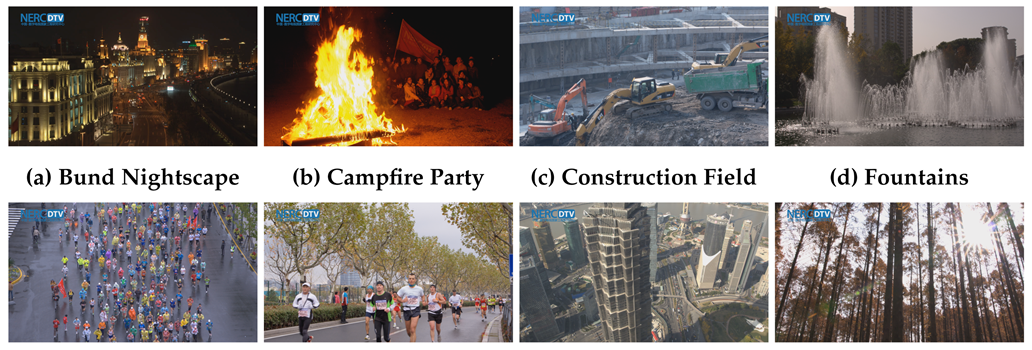
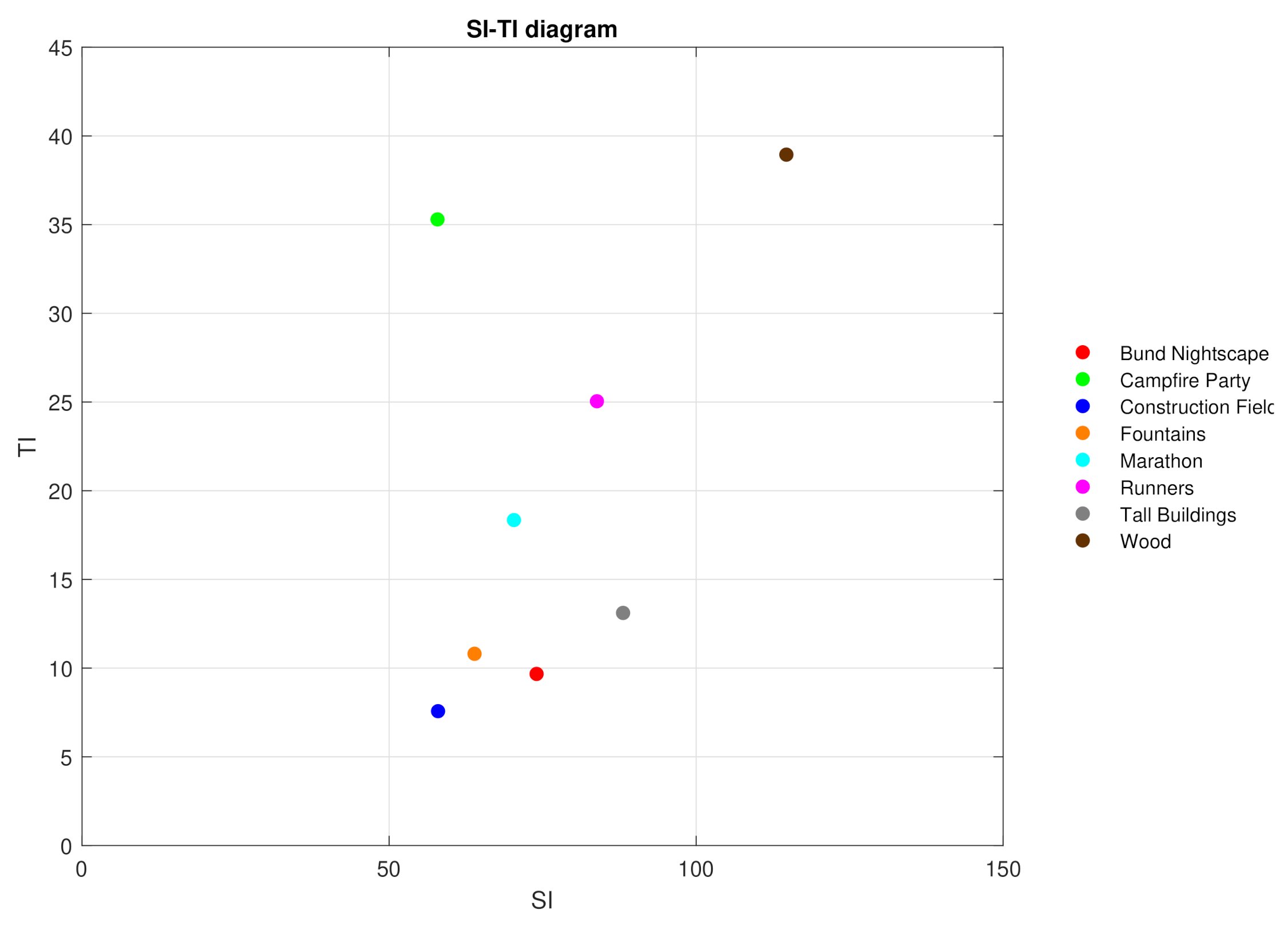

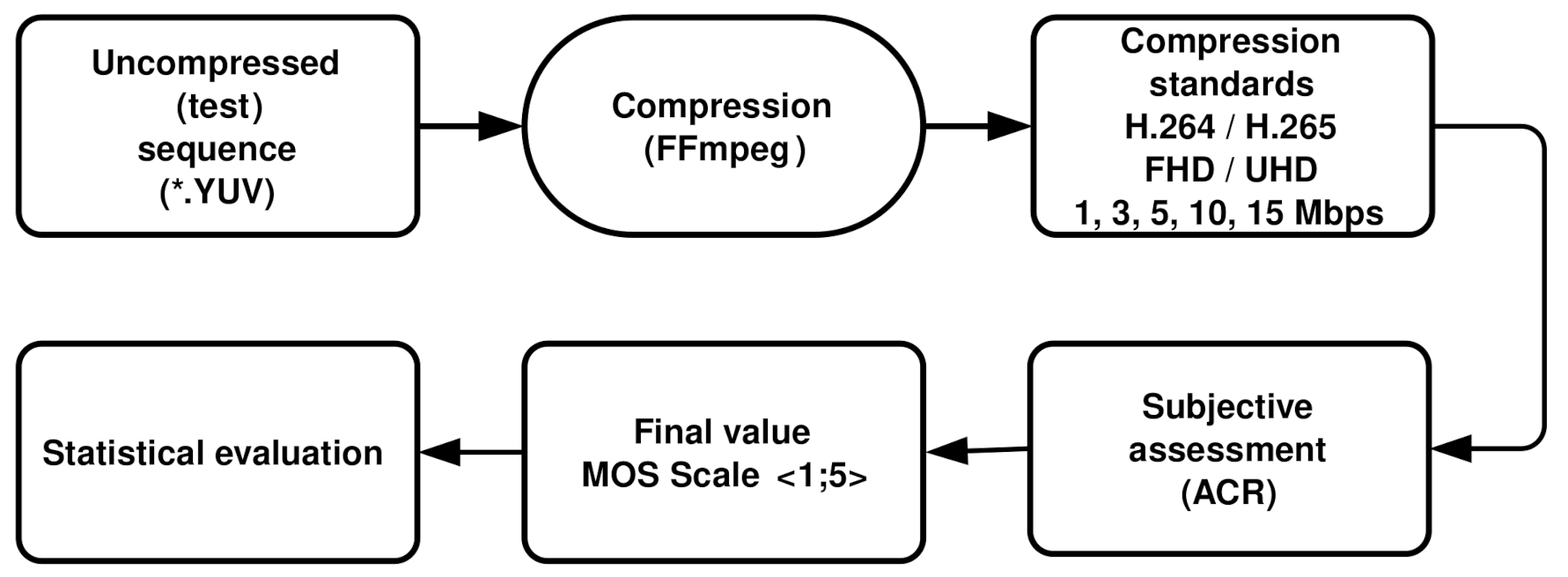

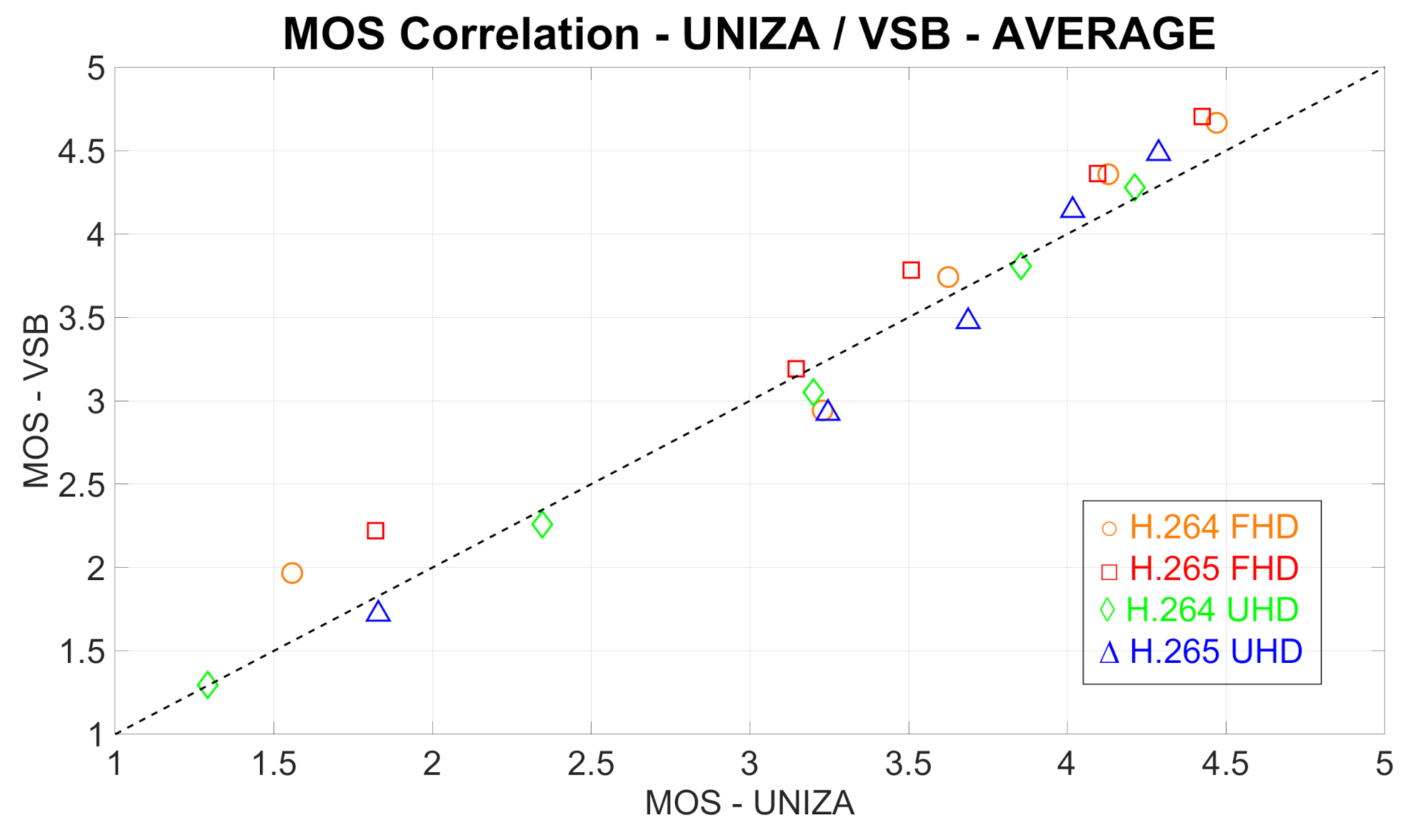
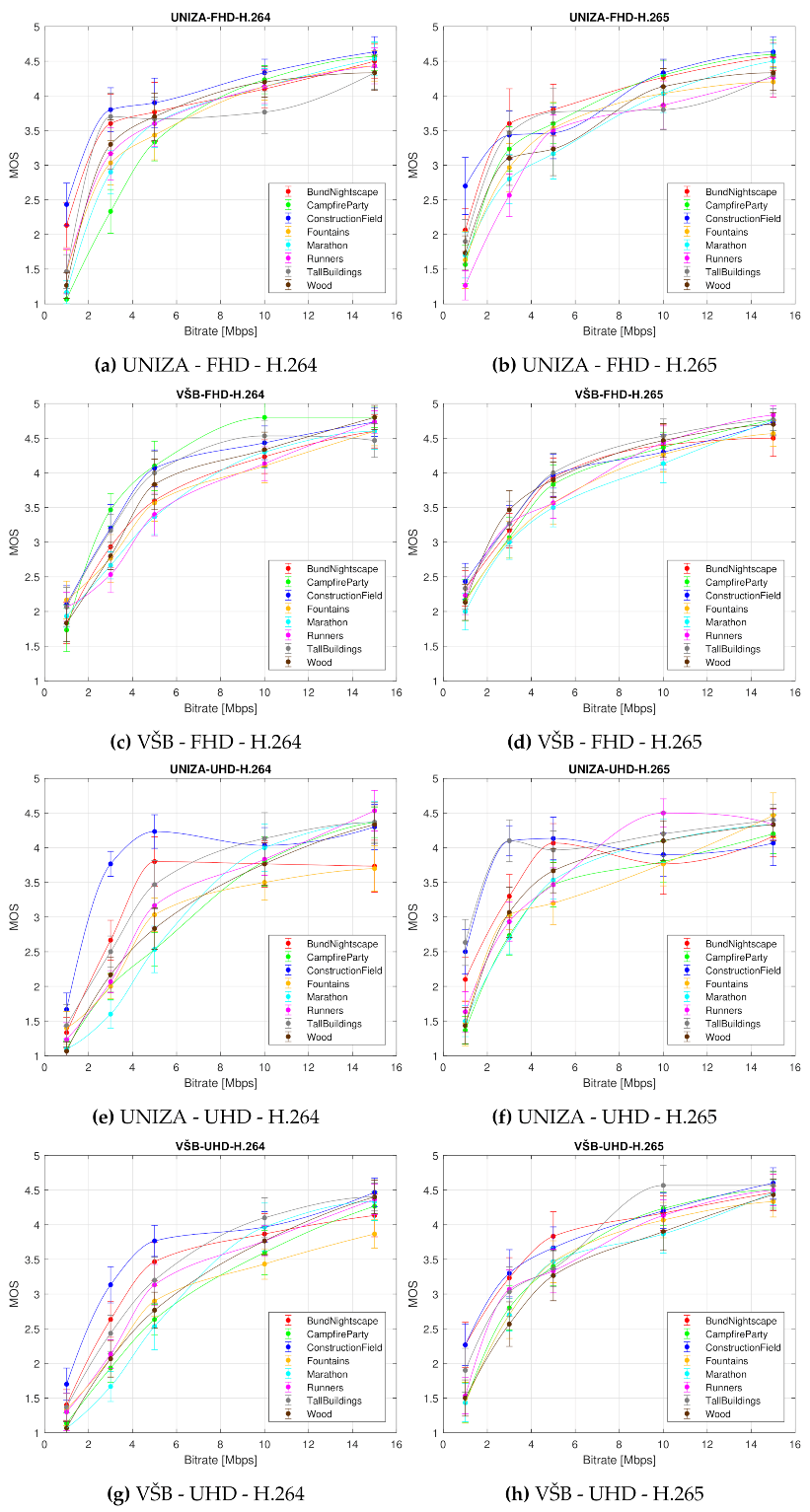


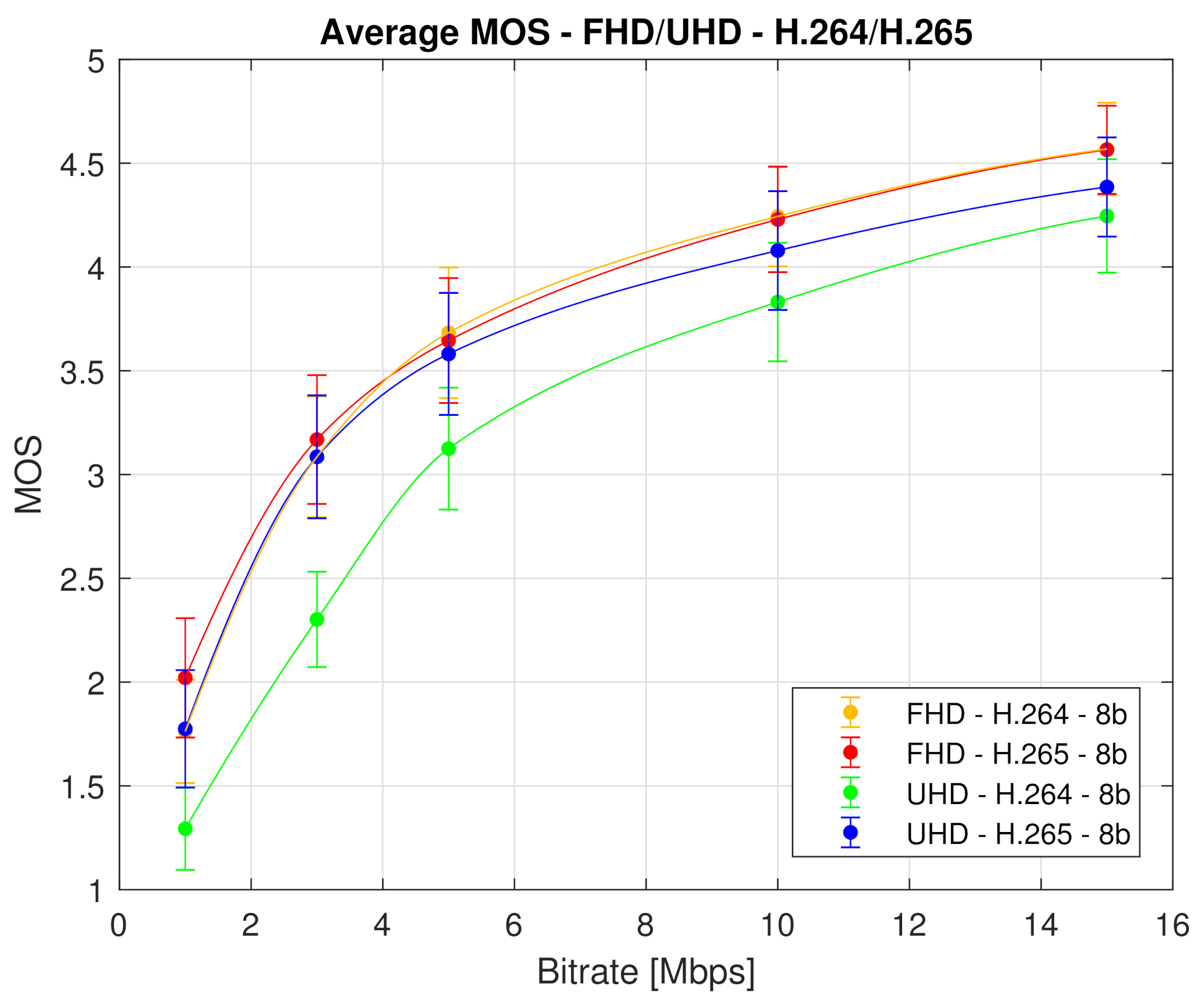
| Resolution | Chroma Subsampling | Bit Depth | Aspect Ratio | Framerate [fps] | Length [Seconds] |
|---|---|---|---|---|---|
| 3840 × 2160 (UHD) | 4:4:4 | 10 bits per channel | 16:9 | 30 | 10 |
| Test Sequence | Description | Test Sequence | Description |
|---|---|---|---|
| Bund Nightscape | is a video sequence portraying the above view of a night city crossed by a busy road next the river. The time-lapse video is captured from a high angle with a steady camera as one extreme long shot. The scene is relatively static, except for the accelerated movement of cars driving on the road, people passing by, flags waving in the wind and flashing lights. | Marathon | is a video sequence picturing a large group of people in colorful apparel running a race on an asphalt road on a rainy day. The sequence was filmed from bird’s eye perspective with almost no camera movement as a very long shot. The scene is rather dynamic, given almost the entire frame is filled by running marathon participants and raindrops falling on the wet road. |
| Campfire Party | is a night time video sequence depicting a group of people posing for a photograph behind a large campfire. The long shot is captured by a stationary camera, which zooms in slightly at the end of the video. The motion in the scene is caused mainly by a flashing fire in the foreground and a woman who briefly runs out of and back into the shot. | Runners | is a video sequence that captures athletes running on a tree lined road in a cloudy weather. The racers in the very long shot are approaching the stationary camera, which is positioned approximately at their eye level. The scene contains a considerable amount of motion caused by rushing contestants and by the wind in the treetops. |
| Construction Field | is a very still video sequence capturing construction equipment in the middle of a building site during excavation work. A hand-held camera was used to film the very long shot from a high angle. The only moving objects in the scene are an excavator digging a foundation pit and people slowly walking in the background. | Tall Buildings | is a video sequence portraying the tallest skyscrapers and busy intersections in Shanghai, with a grand river in the background. The video was captured from a bird’s eye view using a camera that slowly pans to take a panoramic extreme long shot. The movement in the scene is primarily a result of the panning motion of the camera and partially of the cars driving fast at a deep distance. |
| Fountains | is a video sequence focused on several fountains in the left of a housing estate with multiple trees and apartment buildings in the background. The video is captured by a static camera as a long shot. All the motion in the scene can be attributed to water gushing from the fountain jets and droplets evaporating into the air. | Wood | is a video sequence picturing a tall forest during a sunny autumn day. The video was filmed from a low angle as a long shot with a camera performing a moderately fast panning motion. All the movement in the scene can be attributed to the camera pan and the resulting change in the angle of the sunlight rays incident on the lens. |
| Type of Assessment | Type of Display |
|---|---|
| UNIZA − FHD | Samsung LE40C750R2W FHD |
| UNIZA − UHD | Samsung U24E590D UHD |
| VSB − FHD + UHD | 24” Dell P2415Q UHD |
| University | Resolution | Number of Men | Number of Women | Average Age |
|---|---|---|---|---|
| UNIZA | FHD | 25 | 5 | 24 |
| UNIZA | UHD | 21 | 9 | 22 |
| VSB | FHD + UHD | 15 | 15 | 25 |
| UNIZA + VSB | FHD + UHD | 61 | 29 | 24 |
| Pearson CC | RMSE | |
|---|---|---|
| FHD-H.264 | 0.97 | 0.30 |
| FHD-H.265 | 0.99 | 0.31 |
| UHD-H.264 | 1.00 | 0.10 |
| UHD-H.265 | 0.98 | 0.23 |
| H.264 | |||||
| Source of Variation | Sum of Squares | Degrees of Freedom | Mean Square | F-Value | p-Value |
| Bitrate (X1) | 2541.95 | 4 | 635.488 | 982.84 | 0 |
| Scene Type (X2) | 134.03 | 7 | 19.148 | 29.61 | 0 |
| Resolution (X3) | 106.68 | 1 | 106.682 | 164.99 | 0 |
| X1*X2 | 106.58 | 28 | 3.802 | 5.89 | 0 |
| X1*X3 | 34.24 | 4 | 8.561 | 13.24 | 0 |
| X2*X3 | 12.16 | 7 | 1.737 | 2.69 | 0.009 |
| Error | 1518.18 | 2348 | 0.647 | ||
| Total | 4453.83 | 2399 | |||
| H.265 | |||||
| Bitrate (X1) | 1875.05 | 4 | 468.764 | 669.56 | 0 |
| Scene Type (X2) | 90.96 | 7 | 12.994 | 18.56 | 0 |
| Resolution (X3) | 0.12 | 1 | 0.12 | 0.17 | 0.6784 |
| X1*X2 | 88.31 | 28 | 3.154 | 4.51 | 0 |
| X1*X3 | 7.96 | 4 | 1.99 | 2.84 | 0.0229 |
| X2*X3 | 30.65 | 7 | 4.379 | 6.25 | 0 |
| Error | 1643.85 | 2348 | |||
| Total | 3736.91 | 2399 | |||
| Full HD | |||||
|---|---|---|---|---|---|
| Source of Variation | Sum of Squares | Degrees of Freedom | Mean Square | F-Value | p-Value |
| Bitrate (X1) | 2210.04 | 4 | 552.509 | 806.21 | 0 |
| Scene Type (X2) | 82.43 | 7 | 11.776 | 17.18 | 0 |
| Compression Standard (X3) | 0.01 | 1 | 0.007 | 0.01 | 0.9214 |
| X1*X2 | 79.43 | 28 | 2.837 | 4.14 | 0 |
| X1*X3 | 11.11 | 4 | 2.779 | 4.05 | 0.0028 |
| X2*X3 | 16.25 | 7 | 2.322 | 3.39 | 0.0013 |
| Error | 1609.13 | 2348 | 0.685 | ||
| Total | 4008.4 | 2399 | |||
| Ultra HD | |||||
| Bitrate (X1) | 2186.06 | 4 | 546.515 | 842.85 | 0 |
| Scene Type (X2) | 156.8 | 7 | 22.4 | 34.55 | 0 |
| Compression Standard (X3) | 112.23 | 1 | 112.234 | 173.09 | 0 |
| X1*X2 | 145.9 | 28 | 5.211 | 8.04 | 0 |
| X1*X3 | 52 | 4 | 12.999 | 20.05 | 0 |
| X2*X3 | 12.31 | 7 | 1.759 | 2.71 | 0.0084 |
| Error | 1522.48 | 2348 | 0.648 | ||
| Total | 4187.78 | 2399 | |||
| MOS Scale | FHD-8b | UHD-8b | ||
|---|---|---|---|---|
| H.264 | H.265 | H.264 | H.265 | |
| Good (4) | 7.50 Mbps | 7.50 Mbps | 11.55 Mbps | 9.00 Mbps |
| Fair (3) | 2.80 Mbps | 2.60 Mbps | 4.50 Mbps | 2.80 Mbps |
Publisher’s Note: MDPI stays neutral with regard to jurisdictional claims in published maps and institutional affiliations. |
© 2021 by the authors. Licensee MDPI, Basel, Switzerland. This article is an open access article distributed under the terms and conditions of the Creative Commons Attribution (CC BY) license (https://creativecommons.org/licenses/by/4.0/).
Share and Cite
Uhrina, M.; Holesova, A.; Bienik, J.; Sevcik, L. Impact of Scene Content on High Resolution Video Quality. Sensors 2021, 21, 2872. https://doi.org/10.3390/s21082872
Uhrina M, Holesova A, Bienik J, Sevcik L. Impact of Scene Content on High Resolution Video Quality. Sensors. 2021; 21(8):2872. https://doi.org/10.3390/s21082872
Chicago/Turabian StyleUhrina, Miroslav, Anna Holesova, Juraj Bienik, and Lukas Sevcik. 2021. "Impact of Scene Content on High Resolution Video Quality" Sensors 21, no. 8: 2872. https://doi.org/10.3390/s21082872
APA StyleUhrina, M., Holesova, A., Bienik, J., & Sevcik, L. (2021). Impact of Scene Content on High Resolution Video Quality. Sensors, 21(8), 2872. https://doi.org/10.3390/s21082872







